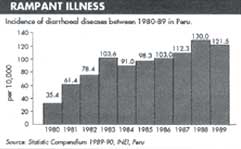Sidelining sanitation
 BURDENED by repayment of its enormous external debt, the Peruvian government has been forced to cut down its budgeting for health and sanitation facilities, even though a cholera epidemic claimed about 4,000 lives there in 1991 and diarrhoeal diseases kill about 17,000 children each year in the country.
BURDENED by repayment of its enormous external debt, the Peruvian government has been forced to cut down its budgeting for health and sanitation facilities, even though a cholera epidemic claimed about 4,000 lives there in 1991 and diarrhoeal diseases kill about 17,000 children each year in the country.
The deteriorating living conditions in Peru's towns and villages is said to be the result of the ineffectiveness of adjustment programmes applied since the mid-1970s.
The government has had to reduce its outlay drastically on health, education, basic sanitation, food and employment during the 1980s, with public spending falling from US $45 in 1981 to US $13 in 1989.
After the cholera epidemic, it was estimated that US $1.6 billion was needed to be spent, but the Peruvian ministry of health has allocated only US $600 million for 1990-95, leaving a serious shortfall that will ensure cholera becomes endemic in the country.
